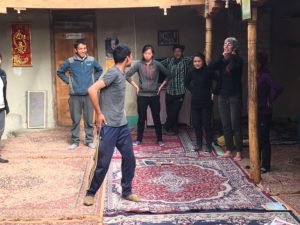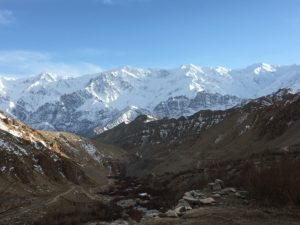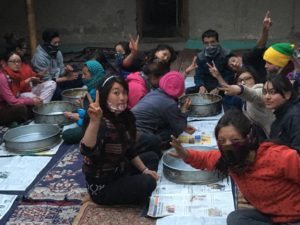As our three-month trip is coming to its end, I am still not sure we really “did India.” Aside from rural Rajasthan, which we fled for some Rajput fortress and desert tourism to recover from a brief and complex taste of Rajasthani village life, we spent a lot of time in the Dravidian south and the Buddhist north, home to a large Tibetan refugee community and more central Asian in character than Indian. We basically skipped the vedantic middle, and what we saw of Delhi looked more like a mixture of Paris, Tel Aviv, and Cairo than our stereotypical idea of “India.” Rereading two of Salman Rushdie’s novels, one set in Kashmir (Shalimar the Clown), the other in Cochin (The Moor’s Last Sigh), helped me to realize that we are not the only ones having trouble reconciling these liminal (=marginal?) places with our received idea of India.
A remote and neglected part of the conflict-ridden state of Jammu-Kashmir, Ladakh is an oasis of peaceful mountain villages, rivers, and Buddhist monasteries that are closer to China and Pakistan than to Delhi.
The reason we went to Leh was to volunteer with SECMOL, an educational and cultural NGO founded by the engineer and sustainability visionary Sonam Wangchuk and co-directed by his former wife Becky Norman whose official title is volunteer coordinator. We learned of SECMOL through Becky’s sister Abigail who runs the Eliot School in Jamaica Plain. (Personal connections and recommendations, along with a lot of serendipity, went a long way in planning our trip.) Becky has lived in Ladakh for over thirty years, as evidenced in her flawless command of the local language on which she’s written a primer. SECMOL has a campus in Phey village and an administrative office in nearby Leh, a small but lively town that caters to the hundreds of tourists and trekkers visiting these parts of the Himalayas every year, though the tourism economy is somewhat depressed by the perennial crisis in Kashmir, which is really quite far away. Ladakhis are proud of their distinctive heritage and aim to preserve it while embracing sustainable development. From what we heard, the political ambition is to establish Ladakh as a “union territory” independent from the state of JK, which would help Ladakhis maintain their own brand and take more immediate control of government resources. This would make sense not only because of the depressed tourism industry but also because the region is woefully underserved by JK government institutions. Schools in remote areas are often closed because teachers don’t show up, the local college in Leh hasn’t seen government administered examinations in a year, and the internet connection cut by an avalanche took more than a month to be restored. As a result, businesses cannot process credit card charges, phone lines are unreliable, tourism entrepreneurs cannot make plans, and so forth.
We stayed a very short three weeks at SECMOL sharing quarters with about 35 high school-age “Foundation” and two groups of older students who either attended college in Leh or were enrolled in the sustainable architecture program on campus. The Foundation students are selected for a one-year remedial course of studies. All basic campus functions, including cooking, cleaning, milking and caring for the cows, shopkeeping, internal discipline and organization are done by the students themselves. Our job was mostly to provide opportunity for English conversation and help with chores. Miriam also taught a series of drawing classes for the Foundation and the architecture students. I gave a five-minute dinner presentation on religion and on a few occasions I jammed with the students using the typical Ladakhi kettle-drums that are usually played with heavy sticks. Once my clarinet had gotten used to the high altitude and dry milieu I was able to resume practicing. I never really got the hang of the Ladakhi tunes the students sang all the time, some of which we recorded, but on my own time I made it through most of Real Book, vol. I. (On the very last day, one of the pads (the Eb flat valve) came off and that was that.)

Playing “Simon Says” in the SECMOL dining hall, a warm-up for conversation class. (Center: Norbu Namgyial)
For the students, a typical day starts at 5:30 (if you have kitchen duty) or 6 am, with morning exercise followed by “introspection.” The days were filled with course-work in English, Ladakhi history, Hindi and Urdu study, conversation class, and most recently with preparatory sessions for the upcoming round of exams. Between 9 and 11 the students take turns for an hour of work around campus as needed and in the afternoon they each have other responsibilities to attend to. One student staffs the small campus store, others are assigned as tour guides for visitors. (SECMOL is well known and attracts many Indian tourists, professionals, and personnel from the nearby military units.) Dinner is around 7pm and includes organizational announcements, student and other presentations, the singing of a Ladakhi “flok-song” and introspection, followed by a scheduled evening activity. The day officially ends at 10pm but the students around us were often awake, talking and singing until midnight, and eventually fell asleep with their lights on.
Most of the students are from Buddhist families. Their villages represent different regions of Ladakh that follow one of four different Buddhist traditions. A small number of students are Muslims. We learned from one of the student presenters that some families are mixed religious and that the different parts of these families honor one another’s religious traditions. An Indian visitor who heard the presentation commented that Ladakh must be the happiest place in all of India as he was unaware that such tolerance obtained anywhere else. (Despite the occasional assurance to the contrary, Hindu-Muslim relations were a topic of concern for many of the people we talked to anywhere we went.)
(To be continued)


